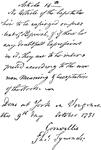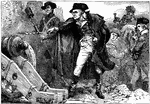Clipart tagged: ‘Yorktown’

Advance of the Federal Army towards Yorktown
When General McClellan reached Locst Hill, on april 2nd, 1862, he found fifty-eight thousand men and…

One of the Articles of Capitulation with Cornwallis's Signature
Lord Cornwallis Surrendered Yorktown to George Washington on October 19, 1781. The terms of surrender…

Howard's Bridge and Mill
"Advance of the Federal troops, near Howard's Bridge and Mill, four miles from Big Bethel, on the road…

First naval battle
"First naval battle in Hampton Roads between the Confederate iron-plated steamers Merrimac, Yorktown,…

Massachusetts Battery
Martin's Massachusetts Battery C opening fire on the Confederate fortifications commanding the approaches…

Second Naval Battle
"Second naval battle in Hampton Roads- fight between the Federal ironclad Monitor, of two guns,…

George Washington at Siege of Yorktown
An illustration of George Washington lighting a cannon at the siege of Yorktown.
